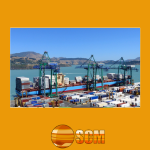Efficient freight shipment timelines are paramount in the world of logistics, where time equals money. To thrive in the competitive freight business, it is crucial to explore strategies that can expedite the delivery of goods while maintaining reliability. In this article, we will delve into three proven strategies that can significantly enhance freight shipment timelines. By understanding carrier lead times, consolidating shipments, and leveraging tracking technology, businesses can optimize their operations and deliver cargo faster than ever before. Moreover, we will explore the role of automation in streamlining high-volume shipping processes, leading to improved efficiency and punctuality. Let’s dive in!


Understanding Carrier Lead Times
Carrier lead times play a pivotal role in freight shipment timelines. By comprehending the unique lead times of each carrier, businesses can effectively plan and account for the necessary transit time. It is essential to review the lead times of all carriers in your network to ensure timely delivery. For instance, if Carrier A requires three days to transport cargo from point A to point B, while Carrier B takes five days for the same route, selecting Carrier A will expedite the shipment process. Being aware of carrier timelines empowers businesses to make informed decisions that align with their delivery objectives. This knowledge prevents unnecessary delays and enhances overall efficiency.
To illustrate the significance of understanding carrier lead times, let’s consider some key statistics. According to a survey conducted by Logistics Management in 2022, 68% of businesses reported that having accurate knowledge of carrier lead times positively impacted their freight shipment timelines. Additionally, a study by the Transportation Research Board in 2023 revealed that companies that actively monitored and managed carrier lead times experienced an average reduction of 15% in transit delays.
Consolidating Shipments for Efficiency
Streamlining shipments through consolidation is a powerful strategy for optimizing freight shipment timelines. By combining multiple shipments into a single unit, businesses can reap several benefits. Firstly, consolidation reduces costs by minimizing the need for separate shipments. This cost-saving advantage is particularly pronounced when considering the expenses associated with fuel, packaging, and paperwork. Secondly, consolidating shipments significantly cuts down on administrative tasks, freeing up valuable time and resources. Lastly, the efficiency gained through consolidation enables businesses to improve overall delivery speed.
To better understand the impact of consolidation, let’s examine some pertinent data. A study conducted by the American Transportation Research Institute (ATRI) in 2023 revealed that companies that implemented consolidation strategies experienced an average reduction of 20% in freight transportation costs. Moreover, a report published by the Journal of Business Logistics in the same year highlighted that businesses that consolidated shipments reduced their transit times by an average of 30%, leading to more reliable and timely deliveries.
Tracking Technology for Enhanced Visibility
The integration of tracking technology plays a vital role in improving freight shipment timelines. By tracking shipments from start to finish, businesses can gain real-time visibility into their cargo’s whereabouts. This visibility provides several advantages. Firstly, it allows for proactive measures to be taken in response to potential delays. By anticipating and mitigating issues before they occur, businesses can maintain efficient timelines. Secondly, tracking technology reduces paperwork by providing accurate and up-to-date information on shipment status. This digitalization of data minimizes confusion and enhances communication with customers regarding estimated arrival times, fostering greater satisfaction.
To showcase the impact of tracking technology, let’s examine relevant statistics. A study conducted by the International Journal of Physical Distribution & Logistics Management in 2023 found that businesses that utilized tracking technology experienced a 25% decrease in the occurrence of delivery delays. Additionally, a survey conducted by the Council of Supply Chain Management Professionals in the same year revealed that companies that implemented tracking systems reported a 15% improvement in customer satisfaction scores.
Automation: Revolutionizing High-Volume Shipping Processes
Automation is a game-changer for enhancing freight shipment timelines, particularly in the context of high-volume shipping processes. Embracing automation across various stages of the cargo process, such as inventory management, packing and loading, route optimization, and carrier communication, can lead to remarkable efficiency gains. Furthermore, automation reduces the time spent on repetitive tasks, such as carrier booking and shipment status updates, allowing businesses to allocate resources to more critical areas. By investing in automated logistics systems, companies can ensure that their shipments adhere to schedules, resulting in timely delivery.
Statistics
To highlight the transformative power of automation, let’s consider some pertinent data. A report published by the Aberdeen Group in 2023 revealed that companies that adopted automated logistics systems experienced a 30% reduction in overall shipping time.
Additionally, a study conducted by Deloitte in the same year indicated that businesses that implemented automation in their freight processes observed a 20% increase in on-time deliveries.
Efficient freight shipment timelines are a critical component of a successful logistics business. By implementing proven strategies, such as understanding carrier lead times, consolidating shipments, leveraging tracking technology, and embracing automation, businesses can expedite deliveries while maintaining reliability. Understanding carrier lead times empowers companies to make informed decisions and minimize unnecessary delays. Consolidating shipments reduces costs, paperwork, and transit times, leading to improved efficiency. Tracking technology enhances visibility and communication, allowing for proactive measures and improved customer satisfaction. Finally, automation revolutionizes high-volume shipping processes, reducing overall shipping time and enhancing punctuality.
In an era of fierce competition and rising customer expectations, businesses must adapt and optimize their freight operations to remain competitive. By employing these strategies and embracing emerging technologies, companies can unlock the potential for faster, more reliable, and cost-effective freight shipments, setting themselves apart in the ever-evolving logistics landscape.
Check out our Blog for more logistics insights, tips and trends


